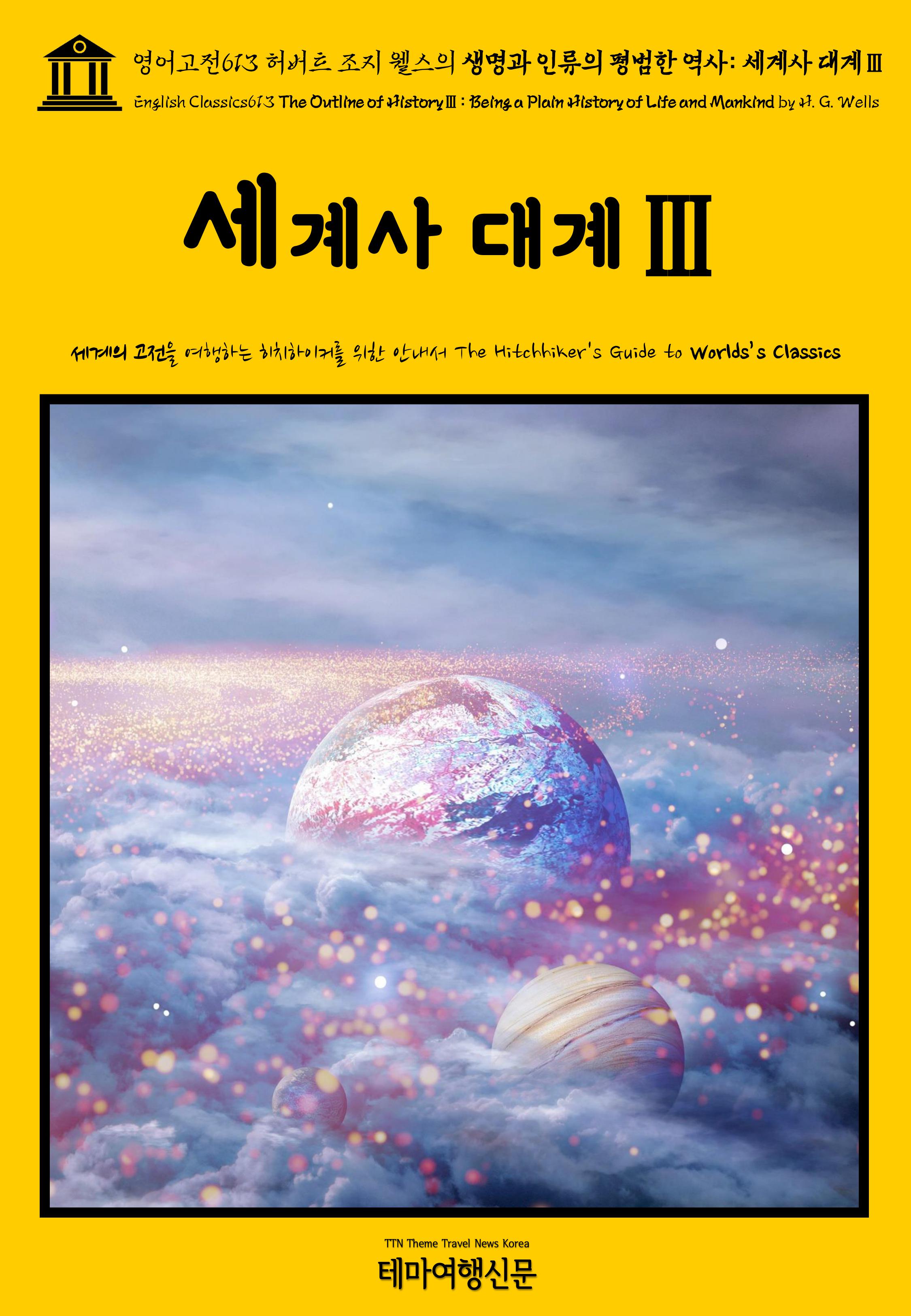▶ 인류의 모든 이야기(The Whole Story of Man) 또는 생명과 인류의 평범한 역사가 되는 것(Being a Plain History of Life and Mankind) : 세계사 대계(The Outline of History)(1920)는 허버트 조지 웰스(H. G. Wells)(1866~1946)의 역사서(history book)입니다. 웰스는 소설가이기 이전에 당대의 지식인이자 역사가, 그리고 교육에 관심이 많은 작가로써 1919년부터 지구의 기원(The origins of the Earth)부터 웰스가 직접 경험한 제1차 세계 대전(The Great War)(1914~1918)까지 세계역사를 연대기별로 일목요연하게 정리해 격주로 연재하기 시작하였습니다. 1920년 연재한 원고를 세계사 대계(The Outline of History)(1920)란 이름의 단행본으로 출간하였으며, 영국을 비롯한 세계 각지에 번역 출간될 정도로 큰 인기를 끌었습니다.
현재까지 최소 200만부 이상이 판매되었으며, 당대 영국 고등 교육기관에서 역사 교육을 위한 필독서로 사랑받았습니다. 또한 조지 웰스는 세계 각지의 오류에 대한 지적을 겸허히 수용하였고, 1937년까지 자신이 직업 원고를 수정하여 개정판을 발간하였습니다. 원고의 완성도 못지않게 당대 유럽인의 우생학과 제국주의에 대한 지지에도 불구하고, 인종주의와 문명적 우월성을 주장하는 이론(theories of racial and civilizational superiority)을 비판한 대목은 현대의 독자에게도 눈여겨볼 만합니다.
▶ THE RACES OF MANKIND. In the early Neolithic Period in Europe?it may be 10,000 or 12,000 years ago or so?man was differentiating all over the world, and he had already differentiated into a number of varieties, but he has never differentiated into different species. A “species,” we must remember, in biological language is distinguished from a “variety” by the fact that varieties can interbreed, while species either do not do so or produce offspring which, like mules, are sterile. All mankind can interbreed freely, can learn to understand the same speech, can adapt itself to co-operation.
인류의 종(種). 10,000~12,000년 전쯤으로 추정되는 유럽의 초기 신석기 시대에 인간은 전 세계적으로 분화하고 있었고 이미 많은 변종으로 분화했지만 다른 종으로 분화한 적은 한 번도 없습니다. 생물학적 언어에서 "종"은 품종이 서로 교배할 수 있는 반면 종은 그렇게 하지 않거나 노새처럼 불임의 자손을 낳는다는 사실에 의해 "다양성"과 구별된다는 사실을 기억해야 합니다. 모든 인류는 자유롭게 교배할 수 있고 같은 말을 이해하는 법을 배울 수 있으며 협력에 적응할 수 있습니다.
▶ 그가 사망한 이후에는 영국 편집자 레이몬드 포스트게이트(Raymond Postgate)(1896~1971)가 제2차 세계 대전(Second World War, WWII)(1939~1945)을 추가하고, 작가의 아들 G. P. 웰스(G. P. Wells)(1901~1985)가 선사시대에 대한 최신 이론을 추가하는 등 지속적으로 업데이트하였습니다. 테마여행신문 TTN Korea 영어고전(English Classics)과 함께 어제도, 오늘도, 내일도 멋진 문학여행을! B
▶ THE ARYAN-SPEAKING PEOPLES IN PREHISTORIC TIMES. WE have spoken of the Aryan language as probably arising in the region of the Danube and South Russia and spreading from that region of origin. We say “probably,” because it is by no means certainly proved that that was the centre; there have been vast discussions upon this point and wide divergences of opinion. We give the prevalent view. As it spread widely, Aryan began to differentiate into a number of subordinate languages. To the west and south it encountered the Basque language, which was then widely spread in Spain, and also possibly various Hamitic Mediterranean languages.
선사 시대의 아리아 어를 사용하는 사람들. 우리는 아마 다뉴브 강과 러시아 남부 지역에서 발생하고 그 기원 지역에서 퍼진 아리아 언어에 대해 이야기했습니다. 그것이 중심이었다는 것이 결코 확실히 증명되지 않았기 때문에 우리는 "아마도"라고 말합니다. 이 점과 광범위한 의견 차이에 대해 방대한 토론이 있었습니다. 우리는 일반적인 견해를 제공합니다. 널리 퍼짐에 따라 아리안(Aryan)은 여러 종속 언어로 분화되기 시작했습니다. 서쪽과 남쪽에서는 바스크어를 접하게 되었는데, 이 언어는 당시 스페인에 널리 퍼졌고, 아마도 다양한 함어족(語族)의 지중해 언어도 사용되었을 것입니다.
▶ SEA PEOPLES AND TRADING PEOPLES. THE first boats were made very early indeed in the Neolithic stage of culture by riverside and lakeside peoples. They were no more than trees and floating wood, used to assist the imperfect natural swimming powers of men. Then came the hollowing out of the trees, and then, with the development of tools and a primitive carpentry, the building of boats. Men in Egypt and Mesopotamia also developed a primitive type of basket-work boat, caulked with bitumen. Such was the “ark of bulrushes” in which Moses was hidden by his mother. A kindred sort of vessel grew up by the use of skins and hides expanded upon a wicker framework.
바다 사람과 무역 사람. 최초의 배는 강변과 호숫가 사람들이 문화의 신석기 시대 단계에서 아주 일찍 만들어졌습니다. 그것들은 인간의 불완전한 자연적 수영 능력을 돕는 데 사용되는 나무와 떠다니는 나무에 불과했습니다. 그런 다음 나무가 움푹 패이게 되었고 도구와 원시 목공 기술의 발달로 보트가 만들어졌습니다. 이집트와 메소포타미아의 남자들도 역청으로 막힌 원시적인 유형의 바구니 작업 배를 개발했습니다. 모세가 어머니에게 숨겨져 있던 “갈대 궤”도 마찬가지였습니다. 고리 버들 세공 틀 위에 확장 된 가죽과 가죽을 사용하여 일종의 용기가 자랐습니다.
▶ SERFS, SLAVES, SOCIAL CLASSES, AND FREE INDIVIDUALS. WE have been sketching in the last four chapters the growth of civilized states out of the primitive Neolithic agriculture that began in Mesopotamia perhaps 15,000, perhaps 20,000, years ago. It was at first horticulture rather than agriculture; it was done with the hoe before the plough, and at first it was quite supplementary to the sheep, goat, and cattle tending that made the “living” of the family tribe. We have traced the broad outlines of the development in regions of exceptional fruitfulness of the first settled village communities into more populous towns and cities, and the growth of the village shrine and the village medicine-man into the city temple and the city priesthood.
농노, 노예, 사회 계급 및 자유 개인. 우리는 지난 4장에서 아마도 15,000년, 아마도 20,000년 전에 메소포타미아에서 시작된 원시 신석기 시대 농업에서 문명국가의 성장을 스케치했습니다. 처음에는 농업이 아니라 원예였습니다. 그것은 쟁기 전에 괭이로 수행되었으며 처음에는 가족 부족의 "생계"를 만든 양, 염소, 소를 돌보는 데 상당히 보조적이었습니다. 우리는 최초의 정착 마을 공동체가 더 많은 인구를 가진 마을과 도시로, 그리고 마을 사당과 마을 의사가 도시 사원과 도시 사제직으로 성장하는 성장의 광범한 개요를 추적했습니다.






